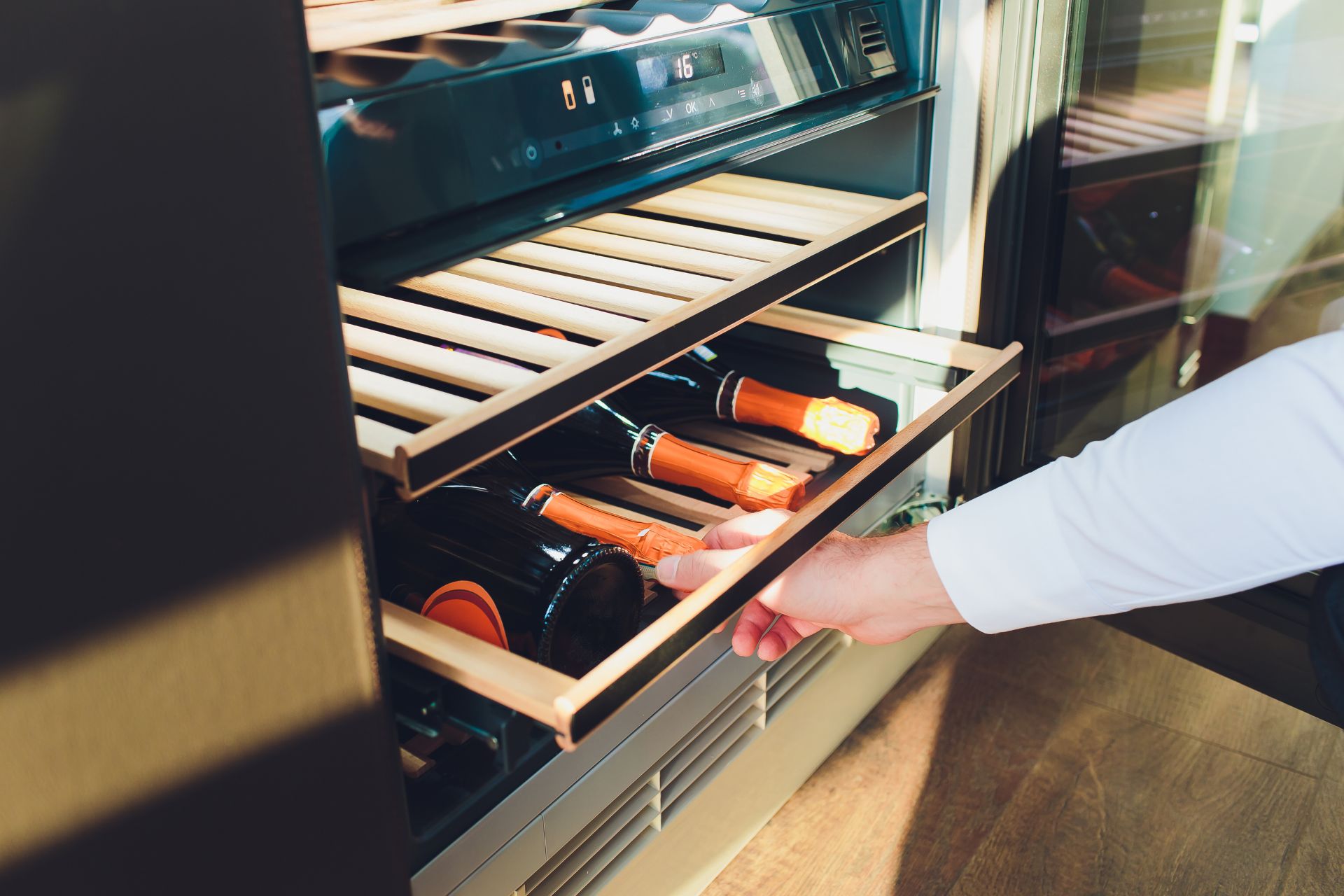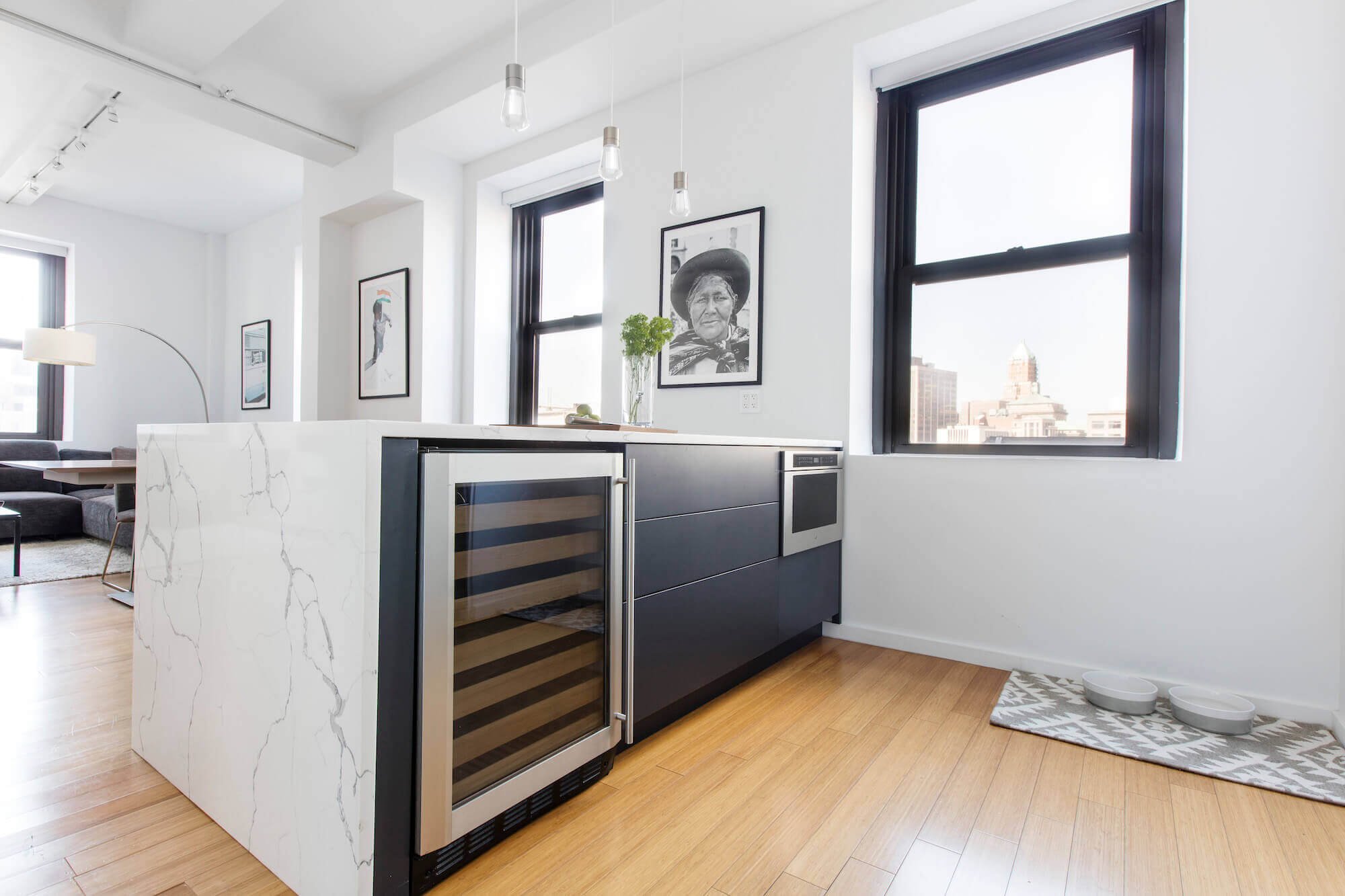Types and Features of Under-Cabinet Wine Fridges: Under Cabinet Wine Fridge In Kitchen

Under-cabinet wine refrigerators offer a stylish and space-saving solution for storing wine in the kitchen. However, choosing the right model requires understanding the various types and features available. This section will explore the key differences between common models, helping consumers make informed decisions based on their specific needs and preferences.
Types of Under-Cabinet Wine Fridges
Under-cabinet wine refrigerators primarily utilize two cooling technologies: thermoelectric and compressor. Thermoelectric units operate using the Peltier effect, which involves the transfer of heat through an electrical current. Compressor units, on the other hand, use a compressor to circulate refrigerant, offering more powerful and consistent cooling. Each technology presents distinct advantages and disadvantages for a kitchen environment.
Comparison of Features: Temperature Zones, Capacity, and Noise Levels
The choice between thermoelectric and compressor models often hinges on the desired features. Compressor units generally provide superior temperature control, often featuring dual or even triple temperature zones for precise storage of different wine types. They typically offer larger capacities, accommodating a greater number of bottles. However, compressor units tend to be louder than thermoelectric models. Thermoelectric units, while quieter, usually have a single temperature zone and a smaller capacity, making them suitable for smaller collections or specific wine types.
Benefits and Drawbacks of Each Type for a Kitchen Setting
Thermoelectric under-cabinet wine fridges are ideal for smaller kitchens or those prioritizing quiet operation. Their compact size and low noise output make them unobtrusive. However, their limited capacity and single temperature zone may restrict their suitability for extensive wine collections or the storage of wines requiring different temperatures.
Compressor under-cabinet wine fridges, while generally louder, offer greater capacity and superior temperature control, making them better suited for larger collections and those who need to store a variety of wines at different temperatures. The enhanced temperature stability ensures optimal wine preservation. However, their larger size and higher noise level may be drawbacks in smaller or noise-sensitive kitchens.
Comparison Table of Under-Cabinet Wine Fridges
The following table compares four hypothetical models, illustrating the variations in price, capacity, and key features. Note that specific models and prices will vary depending on the manufacturer and retailer.
| Model | Price Range | Capacity (Bottles) | Key Features |
|---|---|---|---|
| Model A (Thermoelectric) | $200 – $300 | 12 | Single temperature zone, quiet operation, compact size |
| Model B (Thermoelectric) | $350 – $450 | 18 | Single temperature zone, vibration-free operation, sleek design |
| Model C (Compressor) | $500 – $700 | 24 | Dual temperature zones, larger capacity, digital controls |
| Model D (Compressor) | $800 – $1000 | 36 | Triple temperature zones, high capacity, advanced temperature control, low vibration |
Installation and Integration in the Kitchen

The successful installation and integration of an under-cabinet wine fridge hinges on careful planning and execution. Proper consideration of cabinet dimensions, electrical requirements, ventilation, and overall kitchen design is crucial for optimal performance and aesthetic harmony. Ignoring these factors can lead to malfunctions, inefficient cooling, and a less-than-ideal visual integration within your kitchen space.
Installation Process
Installing an under-cabinet wine fridge typically involves several steps. First, carefully measure the space allocated for the unit, ensuring sufficient clearance for ventilation on all sides, particularly the back and top. Next, check the electrical outlet’s capacity and ensure it meets the fridge’s power requirements. The unit should then be carefully placed in the designated space, ensuring it’s level. Finally, connect the power cord and allow the unit to cool down before loading it with wine bottles. Consult the manufacturer’s instructions for detailed, model-specific guidance. Improper installation can void warranties and potentially damage the appliance.
Cabinet Size and Electrical Requirements
Cabinet dimensions must accommodate the wine fridge’s physical dimensions, including any protruding handles or ventilation grilles. Allow for at least one to two inches of clearance on all sides for proper air circulation. This prevents overheating and ensures efficient cooling. Before purchasing a wine fridge, measure the available space precisely. Regarding electrical requirements, confirm the outlet’s amperage and voltage match the wine fridge’s specifications. Using an adapter or overloading a circuit can pose safety risks and damage the appliance. A dedicated circuit is often recommended for optimal performance.
Ventilation and Condensation Prevention, Under cabinet wine fridge in kitchen
Adequate ventilation is critical for preventing overheating and condensation. Ensure sufficient clearance above and behind the wine fridge for proper airflow. Do not obstruct the ventilation grilles. If the wine fridge is installed in a tight space, consider using ventilation fans or adding additional clearance to improve airflow. High humidity levels can lead to condensation, which can damage the wine bottles and the appliance itself. Maintaining proper ventilation helps regulate temperature and humidity, preventing condensation buildup.
Design Integration Ideas
Seamless integration of a wine fridge depends on the kitchen’s style. In a modern kitchen, a sleek, built-in wine fridge with a minimalist design can enhance the overall aesthetic. Imagine a stainless steel unit seamlessly integrated into a sleek, white cabinetry system, with the handle blending discreetly into the cabinet doors. For traditional kitchens, a wine fridge with a more ornate or wood-fronted design can complement the existing style. Consider a wine fridge with a custom wood panel that matches the kitchen cabinets, creating a cohesive and visually appealing look. A farmhouse-style kitchen might benefit from a wine fridge with a more rustic, exposed finish, blending with the overall charm and character of the space. The key is to choose a wine fridge that complements the existing style and color scheme of the kitchen.
Maintenance and Care

Proper maintenance ensures your under-cabinet wine fridge operates efficiently and preserves your wine collection optimally. Neglecting regular cleaning and maintenance can lead to premature equipment failure and compromise the quality of your stored wines. This section details the necessary steps to keep your appliance in peak condition.
Cleaning and Maintaining an Under-Cabinet Wine Fridge
Regular cleaning is crucial for maintaining hygiene and preventing the buildup of odors that can affect the taste of your wine. Begin by unplugging the unit from the power source. Gently remove all bottles and shelves. Wipe down the interior walls and shelves with a soft, damp cloth and a mild, non-abrasive cleaner. Avoid using harsh chemicals or abrasive cleaners, as these can damage the surfaces. Thoroughly dry all surfaces before replacing the shelves and bottles. Clean the exterior of the unit with a damp cloth, paying attention to the door seal to ensure it remains clean and airtight. Finally, vacuum the condenser coils located at the back or bottom of the unit to remove dust buildup, improving cooling efficiency.
Common Problems and Troubleshooting
Several issues may arise with under-cabinet wine fridges. A consistently warm interior may indicate a malfunctioning compressor or condenser. Check the condenser coils for dust buildup and clean them if necessary. If the problem persists, contact a qualified technician. Excessive noise could stem from a loose component or a failing compressor. Inspect the unit for any loose parts and tighten them securely. Persistent noise warrants professional inspection. A malfunctioning temperature control system may result in inconsistent temperatures. Check the temperature settings and ensure they are accurate. If the problem continues, professional assistance is recommended. Lastly, a leaking unit could be caused by a faulty seal or a damaged water line (if applicable). Inspect the seals and contact a technician if a leak is detected.
Proper Wine Storage for Optimal Preservation
Storing wine correctly is paramount for preserving its quality. Maintain the optimal temperature range specified in your wine fridge’s manual, usually between 50°F and 55°F (10°C and 13°C). Ensure the unit is placed away from direct sunlight and heat sources to prevent temperature fluctuations. Store bottles horizontally to keep the cork moist and prevent it from drying out, which can allow air to enter and spoil the wine. Avoid vibrations, as they can disturb the sediment in the wine and affect its quality. Consider using wine racks designed for proper storage and airflow within the unit.
Maintenance Schedule
A regular maintenance schedule will prolong the life of your wine fridge and ensure optimal wine preservation. The following schedule provides a guideline:
- Weekly: Wipe down spills and remove any dust from the exterior.
- Monthly: Conduct a thorough interior cleaning, using a damp cloth and mild cleaner.
- Quarterly: Vacuum the condenser coils to remove dust buildup. Check the door seals for any damage or leaks.
- Annually: Have a qualified technician inspect the unit for any potential problems. This preventative maintenance can help identify and address issues before they escalate.
